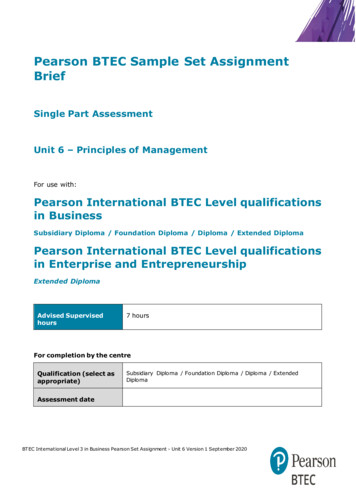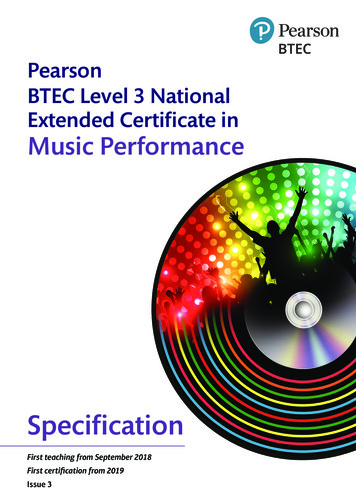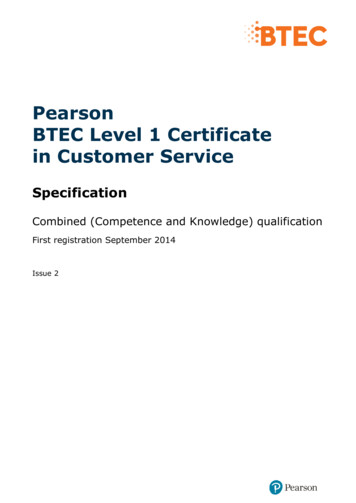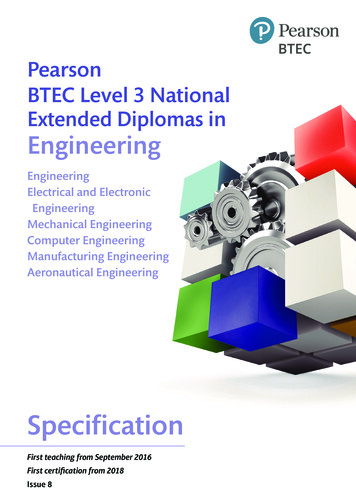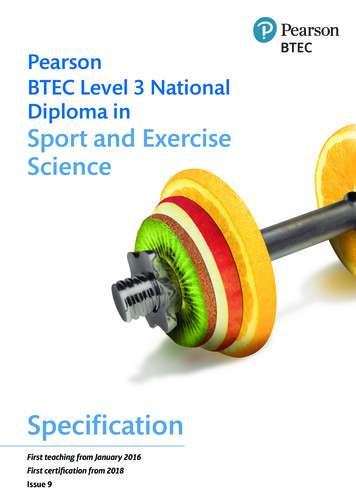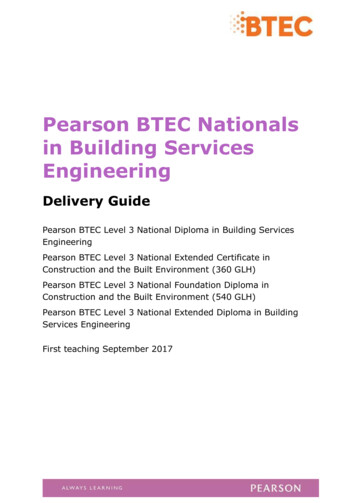
Transcription
Pearson BTEC Nationalsin Building ServicesEngineeringDelivery GuidePearson BTEC Level 3 National Diploma in Building ServicesEngineeringPearson BTEC Level 3 National Extended Certificate inConstruction and the Built Environment (360 GLH)Pearson BTEC Level 3 National Foundation Diploma inConstruction and the Built Environment (540 GLH)Pearson BTEC Level 3 National Extended Diploma in BuildingServices EngineeringFirst teaching September 2017
Edexcel, BTEC and LCCI qualificationsEdexcel, BTEC and LCCI qualifications are awarded by Pearson, the UK’s largestawarding body offering academic and vocational qualifications that are globallyrecognised and benchmarked. For further information, please visit ourqualification websites at www.edexcel.com, www.btec.co.uk or www.lcci.org.uk.Alternatively, you can get in touch with us using the details on our contact uspage at qualifications.pearson.com/contactusAbout PearsonPearson is the world's leading learning company, with 40,000 employees in morethan 70 countries working to help people of all ages to make measurableprogress in their lives through learning. We put the learner at the centre ofeverything we do, because wherever learning flourishes, so do people. Find outmore about how we can help you and your learners atqualifications.pearson.comReferences to third-party material made in this specification are made in goodfaith. Pearson does not endorse, approve or accept responsibility for the contentof materials, which may be subject to change, or any opinions expressedtherein. (Material may include textbooks, journals, magazines and otherpublications and websites.)All information in this specification is correct at time of publication.All the material in this publication is copyright Pearson Education Limited 2017
WELCOMEWelcome to your BTEC National delivery guideThis delivery guide is a companion to your BTEC Level 3 National specifications,Authorised Assignment Briefs (AABs) and Sample Assessment Materials (SAMs).It contains ideas for teaching and learning, including practical activities, realisticscenarios, ways of involving employers in delivery, ways of managingindependent learning and how to approach assessments. The aim of this guide isto show how the specification content might work in practice and to inspire youto start thinking about different ways to deliver your course.The guidance has been put together by tutors who have been close to thedevelopment of the qualifications and so understand the challenges of findingnew and engaging ways to deliver a BTEC programme in the context of the newqualifications from 2017.Guidance around what you will need to consider as you plan the delivery of thequalification(s) has been provided. You will find information around the structureof your course, how you may wish to build the course for your learners,suggestions for how you could make contact with employers and informationaround the other support and resources available to you.Unit-by-unit guidance has been provided, which includes suggestions on how toapproach the learning aims and unit content, as well as ideas for interesting andvaried activities. You will also find coverage of assessments, including usefuladvice about external assessment, as well as tips and ideas around how to planfor and deliver your assignments.You will also find a list of carefully selected resources for each unit. The listsinclude suggestions for books, websites and videos that you can either directyour learners to use or that you can use as a way to complement your delivery.We hope you will find this guidance relevant and useful.Enjoy your course!What’s newThe BTEC Level 3 Nationals 2017 are the result of more than three years’consultation with employers, higher education institutions, and many thousandsof tutors and managers in colleges and schools. Our aim has been to ensure thatthe BTEC Level 3 Nationals continue to allow a recognised and well-respectedroute into employment or higher education by meeting the needs of these keystakeholders and that learners continue to enjoy a stimulating course of studyand develop the skills and attributes that will enable them to progress.As a result of this consultation and on the advice of employers, higher educationinstitutions and most importantly of those of you who teach BTEC, some keychanges have been made to the BTEC Level 3 Nationals. These are describedthroughout this delivery guide and include the following. Updated content and a larger proportion of mandatory content – bothemployers and universities said they wanted a greater consistency incoverage of the subject for BTEC learners. Employers wanted to seesystematic coverage of core knowledge and skills for their sector, and for theNationals to reflect up-to-date industry practice. The reintroduction of external assessment – employers were keen tosee an element of rigour and consistency across the country in terms ofassessment, while higher education institutions wanted learners to be betterprepared for meeting deadlines and preparing for formal exams, whereappropriate. Both were keen to see learners applying their knowledge andskills to new contexts through synoptic projects and assessments.Pearson BTEC Nationals in Building Services Engineering – Delivery GuideIssue 1 – October Pearson 20171
WELCOME A focus on employability skills – the BTEC approach to learning, throughprojects, practical assignments, group work and through simulating the worldof work, has always supported the development of employability skills, e.g.self-management. In the new Nationals, the balance of cognitive and skillswork has been carefully calibrated to ensure that learners get a range ofdifferent opportunities across their course. Broader assessment in internal units – the assessment criteria for eachunit are carefully structured to set a clear level of demand. Distinction criteriaencourage and require depth of study, including demonstration of theapplication of knowledge and understanding as well as a synoptic element forthe learning aim or unit. Alignment with DfE criteria for performance measures for 16–19 yearolds in England – all new BTECs are designed as either Applied Generalqualifications or Tech Levels to fulfil criteria for inclusion in 2018 performancetables and funding for 16–19 year olds and 19 learners.To support transition to the BTEC Level 3 Nationals 2017, we are providing asupport programme with exemplar and practice materials, and training isavailable. Please see the Support and resources section for details of the supportand the link to sign up to training, which will be available from 2017 andthroughout the lifetime of the qualification.Notes:The specification tells you what must be taught and what must be assessed. Thisdelivery guide provides suggestions and ideas on how you could do this.The suggestions given in this delivery guide link with the Authorised AssignmentBriefs provided by Pearson, but they are not compulsory. They are designed toget you started and to spark your imagination.2Pearson BTEC Nationals in Building Services Engineering – Delivery GuideIssue 1 – October Pearson 2017
CONTENTSContentsOverview4Delivery Guides as support4Significant changes for those teaching to the new 2017 specification5Structure6Overview of the Building Services Engineering qualification suite7Making the right choices for your learners8Making contact with employers9Support and resourcesPearson BTEC Nationals in Building Services Engineering – Delivery GuideIssue 1 – October Pearson 2017103
OVERVIEWOVERVIEWDelivery Guides as supportIn the specification, the ‘Unit content’ tells you what must be taught and the‘Assessment criteria’ what must be assessed. The ‘Essential information forassessment decisions’ explains what the assessment criteria mean.This delivery guide provides suggestions and ideas on how to plan and deliverthe qualification, and includes a summary of recent changes.Unit-by-unit guidance has been provided that includes suggestions on how toapproach the learning aims and unit content. Teaching, learning and formativeassessment activities are also suggested. You will also find delivery plans to helpyou timetable your course and ensure your learners are well prepared forinternal and external assessments.Links to carefully selected resources are provided for each unit. The lists includesuggestions for books, websites and videos that will help you plan and deliveryour course. Alternatively, you may wish to direct your learners to theseresources.Use the delivery guides as model templates or an interpretation on which youcan base your own plan. Every delivery guide presents each unit as an exemplar,highlighting building services engineering links to motivate tutors and learners.4Pearson BTEC Nationals in Building Services Engineering – Delivery GuideIssue 1 – October Pearson 2017
OVERVIEWSignificant changes for those teaching to the new 2017specificationThe BTEC Level 3 Nationals 2017 contain significant changes to the previous 2010version. These changes reflect the views and demands of construction teachingpractitioners, those working in the building services engineering sector and governmentbodies with oversight of the qualifications.For those familiar with the older 2010 specification, these changes are summarised inthe table below:ChangeNew 2017Old 2010ProgrammeNameConstruction and the BuiltEnvironment (Building ServicesEngineering)Construction and the BuiltEnvironment (BuildingServices Engineering)No xtended Certificate(Construction & theBuilt Environment)360 GLHSubsidiary Diploma(Construction & theBuilt Environment)360GLHFoundation Diploma(Construction & theBuilt Environment)540 GLH90 – credit Diploma(Construction & theBuilt Environment)540GLHDiploma720 GLHDiplomaExtended Diploma1080 GLHExtended Diploma720GLH1080GLHMandatoryUnitsBetween 4 and 9. All qualificationsBetween 1 and 7Diploma/Extended onlyOptional UnitsChoose from up to 32 dependent onqualificationChoose from up to 33dependent on qualificationAssessmentInternal through assignment and upto 3 External depending onqualificationInternal only throughassignmentsPearson BTEC Nationals in Building Services Engineering – Delivery GuideIssue 1 – October Pearson 20175
OVERVIEWStructure6Pearson BTEC Nationals in Building Services Engineering – Delivery GuideIssue 1 – October Pearson 2017
OVERVIEWOverview of the Building Services qualification suiteThe level 3 Nationals in Building Services Engineering are a suite of qualificationsthat focus on different progression routes, allowing learners to choose the onebest suited to their aspirations. Pearson has developed the content of the newBTEC Nationals in collaboration with employers and representatives from highereducation and relevant professional bodies. This ensures that content is up-todate and that it includes the knowledge, understanding, skills and attributesrequired in the sector.Whereas the previous Nationals were internally assessed only, this new suite ofqualifications has three different types of assessment: internal, external andsynoptic. There is also more of an emphasis on developing and utilising linkswith employers. This may require a review of how the units are delivered andassessed, providing a unique opportunity to create project-based assessmentsthat map across more than one unit, and to embrace employer engagementwhen developing realistic briefs and case studies.These qualifications are aimed at supporting post-16 learners to choosespecialist pathways within building services engineering related industries bygiving them technical skills and required knowledge and hence enable them tofollow their desired career goals such as through employment or suitable highereducation courses. As mentioned earlier, the employers must have significantinvolvement in these programmes.In the Building Services Engineering sector, these are: Pearson BTEC Level 3 National Extended Certificate in Construction and theBuilt Environment (360 GLH) Pearson BTEC Level 3 National Foundation Diploma in Construction and theBuilt Environment (540 GLH) Pearson BTEC Level 3 National Diploma in Building Services Engineering (720GLH) Pearson BTEC Level 3 National Extended Diploma in Building ServicesEngineering (1080 GLH)All qualifications in the suite share some common units and assessments,allowing learners some flexibility in moving between qualifications where theywish to select a more specific progression route. The published programmespecification provides an overview of various qualification sizes clearlyhighlighting both mandatory (M) and optional (O) units. Some units aremandatory across all qualification sizes, while some units are mandatory only forlarger size of the qualification. While choosing the optional units, considerationmust be given to possible coordinated delivery across units, as well as to theefficient use of resources.Pearson BTEC Nationals in Building Services Engineering – Delivery GuideIssue 1 – October Pearson 20177
OVERVIEWMaking the right choice for your learnersYou should support learners in making the right choice that aligns well withfuture aspirations, such as starting a degree or a specific job role in the industry.For example, the Extended Diploma is largest size of qualification within thesuite: It is equivalent in size to 3 A levels and allows the learner to develop asubstantial common core of knowledge. Learners have the choice to study topics in depth across a full range ofoptional units. Learners will develop the broader skills highly valued by higher educationinstitutions, such as critical thinking. A range of written and verbal communication skills required in theconstruction sector will be covered.Hence, such a qualification would suit learners if they are studying full time overa period of two years and want to pursue a career in building servicesengineering. It may be the case that they wish to proceed directly intoemployment as, for example, a technician (as this qualification is intended tomeet the requirements of registering as a technician). Alternatively, thisqualification will also allow learners to progress into higher education.For each qualification, no prior study of the sector is needed, but the learnershould normally have a range of achievement at level 2, in GCSEs or equivalentqualifications, including English, mathematics and science.The smaller size qualifications, such as the Foundation Diploma, cater forlearners who wish to learn about construction alongside other areas of study,such as an A level, and as a support in their progression to higher education.8Pearson BTEC Nationals in Building Services Engineering – Delivery GuideIssue 1 – October Pearson 2017
OVERVIEWMaking contact with employersThe employers in the construction industry range from small designconsultancies to large national and international construction companies.Depending on the size of the qualification, business models of varying sizes willbenefit learners, as well as the optional units that you have chosen.If the centre has well established construction programmes, you could start bycontacting employers who are already on the customer database. If this is notpossible, developing a list of local companies using internet-based searches is agood start. You could also develop a list of relevant staff within, for example, thelocal council, Highway Agency and Environment Agency. You should also look tobuild links with professional bodies such as the Chartered Institute of Building(CIOB), Chartered Institute of Building Services Engineers (CIBSE) andInstitution of Civil Engineers (ICE).Making contact with employers via email or phone is a good start, but ensurethat you are clear regarding the unit content in advance. You should also beflexible with the timing of any site visits or guest speakers. While talking toemployers, it is always worthwhile to articulate the mutual benefits of developinga positive relationship between the centre and the employers. For example, oneof the benefits that they are likely to receive from this relationship could be byoffering work placements, which will give them opportunities for low-riskemployee recruitment, while also contributing towards the local and nationalskills agenda.Pearson BTEC Nationals in Building Services Engineering – Delivery GuideIssue 1 – October Pearson 20179
SUPPORT AND RESOURCESSUPPORT AND RESOURCESThere are a wealth of resources available to ensure that you feel confidentdelivering your BTEC National qualification throughout your entire course.All the ‘Awarding Organisation’ resources can be found on the PearsonQualifications website vironment-2017.htmlAs well as the free resources supporting the qualification, provided by Pearson asan Awarding Organisation, Pearson Learning Services (‘Publisher’ in the tablesbelow) provides a range of engaging resources to support BTEC Level 3Nationals, including: Student books in e-book and print formats Revision guides and revision workbooks in e-book and print formats Teaching and assessment packs, including e-learning materials via theActiveLearn Digital ServiceIn addition to the ‘publisher’ resources listed above, publishers other thanPearson may produce textbooks that are endorsed for BTEC. Check the Pearsonwebsite ished-resources.html)for more information as titles achieve endorsement.10Pearson BTEC Nationals in Building Services Engineering – Delivery GuideIssue 1 – October Pearson 2017
SUPPORT AND RESOURCESThere are also a number of people who are available for you to speak to: Standards Verifiers – they are subject specialists who can support you withensuring that your assessment plan is fit for purpose and whose role is toconfirm that you are assessing your learners to national standards asoutlined in the specification by providing quality assurance through sampling. Curriculum Development Managers (CDMs) – they are regionally basedand have a full overview of the BTEC qualifications and of the support andresources that Pearson provides. CDMs often run network events. Customer Services – the ‘Support for You’ section of our website gives thedifferent ways in which you can contact us for general queries. For specificqueries, our service operators can direct you to the relevant person ordepartment.Subject AdviceTeachingConstruction@pearson.comTraining for the new BTEC Level 3 Nationals can be found on the Pearson websitehere: ing-from-pearsonuk.htmlPearson BTEC Nationals in Building Services Engineering – Delivery GuideIssue 1 – October Pearson 201711
UNIT 27: BUILDING SERVICES CONTROL SYSTEMSUnit 27: Building Services Control SystemsDelivery guidanceApproaching the unitThe focus during the delivery of ‘Unit 27: Building Services Control Systems’ should beon developing knowledge and understanding of the purpose and function of buildingservices control systems, and the operational characteristics of control components anddevices.Drawings, illustrations, images, animations and video clips are all useful resources toexplain the principles governing control systems as well as to understand operationalcharacteristics of control devices. Such resources are freely available online and can beeasily incorporated into tutor presentations.In addition to this, site visits to a large project or to a manufacturing facility wherelearners could have first-hand experience of both electrical and mechanical controlsystems such as heating, ventilation, air conditioning, refrigeration and lighting are alsouseful. The number and frequency of such site visits would vary according to yourdelivery schedule and availability of the site(s).Involving local professionals and experts from the building services engineering designand construction sector as guest speakers will be helpful, in order to enthuse learners asthey gain an insight into the current practices within the industry.Tutors could either develop a project brief or adapt an actual case study or designexample, which can be used as a learning resource (ideally throughout the delivery of theunit). This would help learners to develop a holistic understanding of the subject.As this unit concentrates on different forms of technology applied to various mechanicaland electrical building engineering services, it would be appropriate to deliver this unit ata point where learning on other building services units has happened, or is happeningalongside this unit.Delivering the learning aimsLearning aim ALearning aim A focuses on the principles underpinning building control systems, such ascontrol loops and control modes. It will enable learners to develop an understanding ofthese principles that will help them to appreciate operational features of devices andsystems, as well as their purposes.Throughout the delivery of this learning aim, engage learners with knowledge quizzes,paired and/or group activities, class discussions and presentations. These providelearners with opportunities for peer learning.Tutors could introduce control loops and modes by using animations, DVDs, examples,illustrations or web-based videos (some suggested resources have been provided in the‘Resources’ section). Once the basic principles have been understood, learners canparticipate in more ‘in-depth’ group activities and class discussions. For example,learners can comment upon the rationale behind a specific control system in terms of itsuse and benefits.Further activities may include conducting independent research and small grouppresentations on control modes and the operational characteristics of various controlsystems.Site visits are key to engaging learners. For example, an early visit to a site where arange of control systems is being installed will help to consolidate learner understandingPearson BTEC Nationals in Building Services Engineering – Delivery GuideIssue 1 – October Pearson 20171
UNIT 27: BUILDING SERVICES CONTROL SYSTEMSof the content within learning aim A. The site visit will also reinforce learning aboutlegislative requirements and approaches to providing building control systems.Learning aims B and CLearning aim B and learning aim C could be delivered using a project-based approach.These learning aims deal with the application of the principles learned in learning aim Aand are very practical in nature. Learners have to produce a complete system design andjustify their selection of the various systems and components.For the delivery of these learning aims, the introduction of systems and controlcomponents followed by well-structured research tasks would be beneficial for learners.Tutors could then introduce real-life case studies of large commercial or industryprojects. Learners would require access to project drawings, manufacturer’sspecifications, design data and project reports to quote some examples. Tutors couldcontact the companies for such information, which are often more than willing to help.Tutors could also arrange for a guest speaker to visit the centre, such as a site manager,design engineer or a technical staff member working at the local council. The guestspeaker could share some examples with learners of current design and installationprinciples that are found within the industry.Ensure that the appropriate safeguards are in place during the site visit, and coordinatewith site staff in advance so that all parties are aware of the learning opportunities duringthe visit. Reinforce this learning in class, using project-related data.Learners need to consolidate their knowledge through the use of case studies, which caninclude interesting problem-solving challenges for them. For example, tutors could tasklearners with exploring the challenges and impacts of using alternative types of sensors,actuators, controlled devices and controllers for given, specific building servicesinstallations. To provide access to more case studies, tutors could either approachcompanies for relevant information, or download examples from the web.2Pearson BTEC Nationals in Building Services Engineering – Delivery GuideIssue 1 – October Pearson 2017
UNIT 27: BUILDING SERVICES CONTROL SYSTEMSAssessment model (in internally assessed units)Learning aimKey content areasRecommendedassessment approachA Understand theprinciples associated withbuilding services controlsystemsA1 Control loopsAnalyse a client brief interms of the modes ofcontrol and operationalfeatures.B Apply the principles ofbuilding services controlsystems and the functionand operationalcharacteristics of controlsystemsB1 Generic functionsA2 Modes of controlA3 Operational featuresA4 Purpose of controlsystemsB2 Safety controls andfunctions of safety controlsystemsB3 Operationalcharacteristics of controldevices and componentsDevelop a control systemfor a scenario, from a set ofcriteria.As part of the solution,produce a specification forall elements of theinstallation.B4 The role of thecomputer technology incontrol systemsC Develop an appropriatespecification andschematic drawings forbuilding services controlsystemsC1 Control functionsC2 Control strategiesC3 DrawingsAssessment guidanceThere is a maximum number of two summative assignments for this unit. Theassignment briefs should be set within the context of a large building servicesengineering project, such as a commercial or an industrial building.For learning aim A, give learners a case study containing adequate details about abuilding services control system, so that they could justify the proposed control systemas well as the use of various control components and their operational features. Thejustification must relate to the given case study, drawing on their experience andknowledge of the factors to consider in the design of any building services controlsystem.For learning aims B and C, tutors should include sufficient details so that learners couldproduce system design and justify the selection of systems and components. Involvinglocal employers in the assessment or using one of the industry projects will be beneficialfor the learners.Submitted assessment evidence could be in the form of a project or an investigativereport and a proposal. Tutors could ask learners to include drawings, sketches,illustrations, manufacturers’ data and a list of information sources used.Pearson BTEC Nationals in Building Services Engineering – Delivery GuideIssue 1 – October Pearson 20173
UNIT 27: BUILDING SERVICES CONTROL SYSTEMSGetting startedThis provides you with a starting place for one way of delivering the unit, basedaround the recommended assessment approach in the specification.Unit 27: Building Services Control SystemsIntroductionIntroduce learners to the unit using animations, DVDs, pictures, illustrations or webbased videos relating to the building services control systems used within the contextof a large construction project.Engage learners during the delivery of the unit content through knowledge quizzes,paired or group activities, class discussions and presentations, as well as through guestspeakers and site visits.Develop a project brief within the context of a large building services engineeringproject, such as a commercial or an industrial building, which will provide plenty ofopportunities for learners to collate evidence across all three learning aims for theirassessments. This could be a case study or project data obtained through any relatedindustry links. After the initial delivery of each learning aim, use this project as a toolfor application of the principles learned.Well-organised site visits are invaluable for the delivery of this unit. Visits will need tobe timetabled carefully to ensure that learners have sufficient knowledge across thelearning aims to fully benefit from the experience. The site visits for this unit could alsobe done in conjunction with the visits from other units. It is critical to coordinate withthe site staff in advance to confirm the: health and safety requirements type of control systems and components used extent to which the site staff could engage (project presentation, access todrawings, project data).Learners could prepare checklists before the visits, so that they can record details ofthe different components and processes relating to the control systems. If findingappropriate sites proves difficult, tutors could instead use project examples throughDVDs or other project data.Learning aim A – Understand the principles associated with buildingservices control systems The delivery of this learning aim would benefit from a site visit for learners toexamine the installation of building services control systems. If a visit is notpossible, use of online resources and video clips can enhance tutor-ledpresentations and classroom-based activities. For the delivery of learning aim A1, tutors could begin with delivering apresentation to introduce the topic by showing how control loops work usinganimations, DVDs, illustrations or web-based videos. This should include open,closed, single and multi-loops. Facilitate a class discussion on the benefits anddrawbacks of each type. For the delivery of A2, learners are to consider the various modes of control. Tutorscould give learners a group research activity where they are to find examples ofeach mode (e.g. two-position, proportional and integral controls). They are tosummarise the key points, presenting their findings back to the class and includingany additional information as necessary. In the following session, for the delivery of learning aim A3, tutors can deliver apresentation on the operational features of control systems, while also usingexamples. This should include the performance of control systems in terms of4Pearson BTEC Nationals in Building
education courses. As mentioned earlier, the employers must have significant involvement in these programmes. In the Building Services Engineering sector, these are: Pearson BTEC Level 3 National Extended Certificate in Construction and the Built Environment (360 GLH) Pearson BTEC Level 3 National Foundation Diploma in Construction and the


